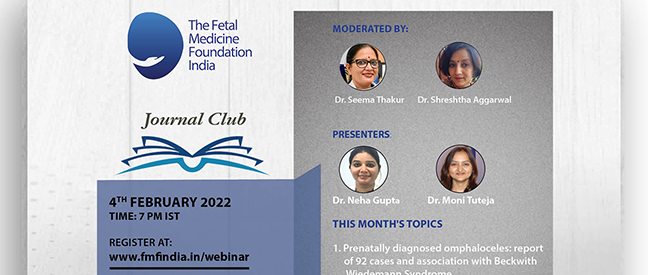Take home messages from the 4th February Journal Club meet

Prenatally diagnosed omphaloceles: Report of 92 cases and association with Beckwith Wiedemann syndrome. PND, Vol 41 (7), 798-816
Abbasi N et al
Beckwith‐Wiedemann syndrome (BWS) is the most common pediatric overgrowth syndrome, classically characterized by omphaloceles, macroglossia, and overgrowth and is associated with 2%–22% of antenatally diagnosed omphaloceles. Macrosomia, macroglossia and visceromegaly typically occur later in gestation or postnatally. The chromosomal region 11p15.5 spans ~ 1 Mb and harbors two separate imprinting control regions (ICRs):
- The telomeric one, ICR1, includes the H19/IGF2:IG-DMR, which is methylated on the paternal allele,
- The centromeric one, ICR2, includes the KCNQ1OT1:TSS-DMR, which is maternally methylated.
Four different types of molecular changes have been reported in BWS
- Imprinting due to hypomethylation at ICR2 (40-50%) or hypermethylation of ICR1
- Uniparental disomy
- Deletions/duplications
- Point mutations
Molecular testing of BWS involves MS-MLPA as the primary technique for detecting epigenetic and genetic variations at 11p15 including microdeletions, microduplications, alterations in gene dosage, and DNA methylation at two imprinting centers as well as UPD, followed by other techniques such as Karyotype for chromosomal rearrangements, genetic sequencing for point mutation analysis. It is important to know the mechanism of BWS to delineate the recurrence risk.
In this paper by Abbasi et al, the authors studied 92 cases (2010-2015) of prenatally diagnosed omphalocele and report association with BWS in 19 cases. An echocardiogram and detailed fetal ultra- sound were performed, and amniocentesis was offered with karyotype/microarray analysis and BWS molecular testing. Perinatal, neonatal, and long‐term outcomes were retrieved for BWS cases.
- Over the 15 year‐study period, the prevalence of BWS was approximately 8% among prenatally diagnosed omphaloceles
- Two cases were part of MCDA twins which were discordant for BWS.
- With routine implementation of BWS testing for prenatally diagnosed omphaloceles, BWS was identified in 37% and 7% of isolated and non‐isolated omphaloceles respectively, after exclusion of aneuploidy
- Mortality was 20%, embryonal tumors were detected in 12.5% and neurodevelopment was normal in 75%
- BWS should be considered in prenatally diagnosed isolated omphaloceles, after exclusion of chromosomal abnormalities
- This series highlights the importance of expanded molecular analysis for BWS, and long‐ term follow‐up for malignancies and neurodevelopment.
Clinical experience with noninvasive prenatal screening for single gene disorders- ISUOG, Vol 59(1), 33-39, Mohan et al
It is now 10 years since analysis of cell free DNA (cfDNA) in maternal blood was introduced clinically as a highly specific and sensitive screening test for fetal trisomies. In this study, Mohan et al report on clinical experience with NIPT-SGD, which focuses on a specific set of dominantly inherited or de-novo gene variants in 30 genes.
Single-gene disorders (SGD) are present in approximately 1% of births. NIPT-SGD is feasible for a broad range of monogenic disorders and is most straightforward when applied for the detection of dominant conditions with a high de-novo rate OR for paternally inherited dominant gene variants. A currently available NIPT-SGD panel screens for 25 conditions that result from disease-causing variants across 30 genes which have a combined incidence of 1 in 600 (0.17%). The conditions include Noonan spectrum disorders (NSD), skeletal disorders, craniosynostosis syndromes, Cornelia de Lange syndrome (CdLS), Alagille syndrome, tuberous sclerosis, epileptic encephalopathy, SYNGAP1-related intellectual disability, CHARGE syndrome, Sotos syndrome and Rett syndrome.
Diagnostic yield is 5.7% in overall cases taken up in the study and the detection rates are higher in cases tested for fetal long-bone abnormalities (33.7%), fetal craniofacial malformations (28.6%), family history of a disorder included in the panel (15.2%), fetal lymphatic abnormalities (13.3%) and fetal cardiac abnormalities (12.9%). No false-positive or false-negative results were found in the cases which were followed up which was limited to screen positive cases.
NIPT-SGD is in its earliest stages of development and considerable potential exists to expand its scope through the sequencing of more genes. This study demonstrates the potential value of NIPT-SGD, particularly in cases with abnormal ultrasound findings or with a relevant family history. If implemented correctly with close counselling and monitoring, NIPT-SGD offers a safe and timely prenatal screening option for at risk couples.


